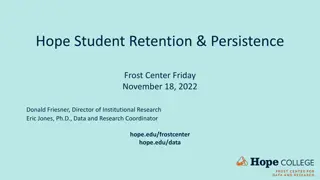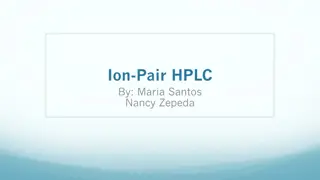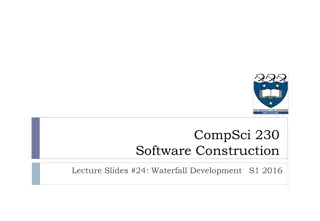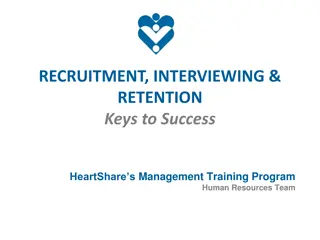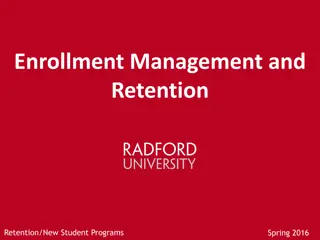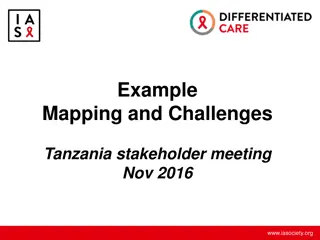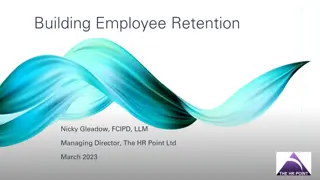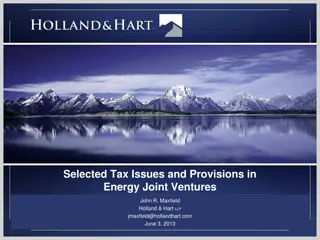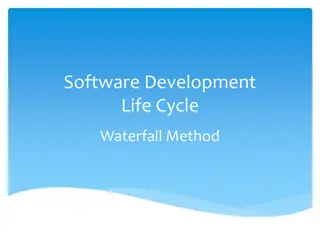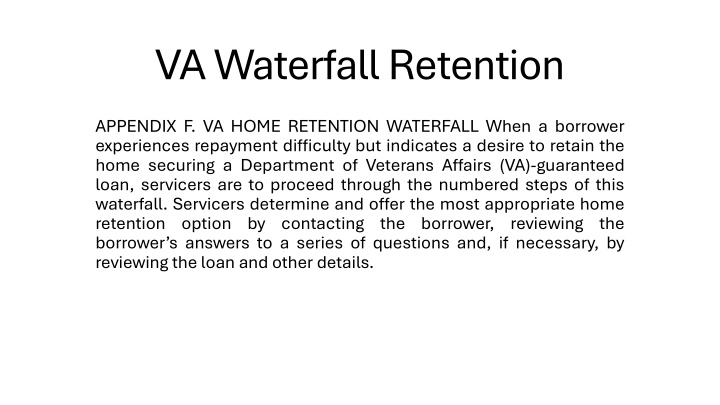
VA Home Retention Waterfall Steps for Borrower Assistance
Discover the steps involved in VA Home Retention Waterfall for borrowers experiencing repayment difficulties, ensuring retention of their Department of Veterans Affairs (VA)-guaranteed loan by offering suitable options and evaluating the borrower's situation.
Download Presentation

Please find below an Image/Link to download the presentation.
The content on the website is provided AS IS for your information and personal use only. It may not be sold, licensed, or shared on other websites without obtaining consent from the author. If you encounter any issues during the download, it is possible that the publisher has removed the file from their server.
You are allowed to download the files provided on this website for personal or commercial use, subject to the condition that they are used lawfully. All files are the property of their respective owners.
The content on the website is provided AS IS for your information and personal use only. It may not be sold, licensed, or shared on other websites without obtaining consent from the author.
E N D
Presentation Transcript
VA Waterfall Retention APPENDIX F. VA HOME RETENTION WATERFALL When a borrower experiences repayment difficulty but indicates a desire to retain the home securing a Department of Veterans Affairs (VA)-guaranteed loan, servicers are to proceed through the numbered steps of this waterfall. Servicers determine and offer the most appropriate home retention option by contacting the borrower, reviewing the borrower s answers to a series of questions and, if necessary, by reviewing the loan and other details.
Determine What Caused The Default Step 1. The servicer determines whether the borrower was affected by a Presidentially declared disaster. For borrowers affected by such a disaster, the servicer may offer the borrower either a VA Disaster Modification or a Disaster Extend Modification, depending on whether the respective criteria are met. If the loan meets the criteria for both, the servicer will choose the option that provides a better outcome for the borrower. If the borrower cannot afford either option, the servicer proceeds to Step 2. If the borrower can afford such an option but does not agree to the modification, the servicer offers alternatives to foreclosure or proceeds to foreclosure, as appropriate. A servicer may contact VA for further evaluation of a loan, on a case-by-case basis. For borrowers not affected by such a disaster, the servicer proceeds to Step 2
Repayment Plan Step 2. The servicer asks if the borrower can afford to repay the missed payments in a lump sum and/or can afford to enter into a repayment plan with scheduled partial monthly mortgage payments. If the borrower can afford to repay the missed payments in a lump sum during the forbearance timeframe and/or could afford a repayment plan with scheduled partial monthly mortgage payment, the servicer offers the borrower a Special Forbearance to allow time to gather and submit the funds to reinstate. If the borrower cannot afford such payments, the servicer proceeds to Step 3. If the borrower reaches the end of the Special Forbearance timeframe and has not reinstated the loan, the servicer proceeds to Step 3. A servicer may contact VA for further evaluation of a loan, on a case- by-case basis
Step 3. The servicer asks if the borrower can afford the current monthly mortgage payment, plus additional amounts, until the loan is current. If the borrower can afford the current monthly mortgage payment, plus additional amounts until the loan is current, the servicer discusses a Repayment Plan with the borrower. If the borrower can afford the servicer s terms, then the servicer offers the borrower a Repayment Plan. If not, the servicer proceeds to Step 4. If the borrower can afford such terms but does not agree to the Repayment Plan, the servicer offers alternatives to foreclosure or proceeds to foreclosure, as appropriate. A servicer may contact VA for further evaluation of a loan, on a case- by-case basis
Home Modification Step 4. The servicer asks if the borrower can afford the current monthly mortgage payment. If the borrower can, the servicer discusses the Traditional VA Modification with the borrower to see if new terms can bring the loan current, without increasing the monthly payment. If the borrower can afford the servicer s terms, then the servicer offers the borrower the Traditional VA Modification. If not, the servicer proceeds to Step 5. If the borrower can afford such terms but does not agree to the Traditional VA Modification, the servicer offers alternatives to foreclosure or proceeds to foreclosure, as appropriate. A servicer may contact VA for further evaluation of a loan, on a case-by-case basis
Step 5. The servicer reviews the loan to determine if the terms could be modified under a 30- year modification to decrease the current monthly principal and interest payment by at least 10%. If so, the servicer offers the borrower the 30-year modification. If not, the servicer proceeds to Step 6. If the borrower does not agree to the 30-year modification, the servicer cannot proceed to the Veterans Affairs Servicing Purchase (VASP) review (i.e., the servicer cannot proceed beyond Step 5). The servicer offers alternatives to foreclosure or proceeds to foreclosure, as appropriate
Loan Review If the borrower/s agree to the terms of the new loan, 30 or 40 year modification, regardless of any reflected decrease in principal or interest. If the borrower does not agree to the 40-year modification, the servicer cannot proceed to VASP review (i.e., the servicer cannot proceed beyond Step 7). The servicer offers appropriate alternatives to foreclosure or proceeds to foreclosure, as appropriate.
New Loan The servicer determines whether a Trial Payment Plan (TPP) is necessary. If the TPP is not necessary and the borrower can afford the new payment calculated for the VASP, the servicer offers the borrower the VASP. If the TPP is necessary and the borrower can afford the new payment calculated under the VASP, the servicer offers the VASP, subject to the successful completion of the TPP. If the borrower cannot afford the VASP or does not agree to the VASP, the servicer offers alternatives to foreclosure, as appropriate
The Veteran Administration Disability Rate Changes for 2025 Understanding the Updates and Their Impact on Veterans
VIDEO OF VA CHANGES 2025 https://youtu.be/-uipmsxNxVo?si=Mjpqkc6EidEk6ZU8 https://www.youtube.com/watch?v=-uipmsxNxVo&authuser=0 https://youtu.be/-uipmsxNxVo?si=fg8UoW4d1jBV9BpY Final Action 08/00/2025
2025 VA Disability Ratings for Mental Health The new rating system represents a significant departure from previous evaluation methods. Veterans and their healthcare providers now have clearer guidelines for documenting and assessing the impact of mental health conditions on daily life. This change aims to provide more accurate and fair disability ratings that better reflect the real-world challenges veterans face.
The Five Domains 1.Cognition (understanding and communicating) 2.Interpersonal interactions and relationships 3.Task completion and life activities 4.Navigating environments 5.Self-care
Evaluating Multiple Mental Health Conditions Mental health conditions often overlap and interact with each other in complex ways. Understanding this, the VA will assign only one rating for co-existing mental health conditions. This prevents "pyramiding" -getting multiple ratings for the same symptoms under different diagnoses -while ensuring that the total impact of all conditions is fairly evaluated.
2025 VA MENTAL HEALTHCARE RATINGS 100%: Level 4 impairment in one or more domains, OR Level 3 in two or more domains 70%: Level 3 impairment in one domain, OR Level 2 in two or more domains 50%: Level 2 impairment in one domain 30%: Level 1 impairment in two or more domains 10%: Minimum rating for any service-connected mental health condition
RECAP MENTAL CHANGES Domain 1. 1. Cognition: Cognition: May include, but is not May include, but is not limited to, memory, concentration, limited to, memory, concentration, attention, goal setting, speed of attention, goal setting, speed of processing information, planning, processing information, planning, organizing, prioritizing, problem organizing, prioritizing, problem solving, judgment, making solving, judgment, making decisions, or flexibility in adapting decisions, or flexibility in adapting when appropriate. when appropriate. Level of impairment Criteria No difficulties: Cognitive functioning intact. Mild: Slight difficulties in one or more aspects of cognitive functioning that do not interfere with tasks, activities, or relationships. Moderate: Clinically significant difficulties in one or more aspects of cognitive functioning that interfere with tasks, activities, or relationships. 0 = None 1 = Mild impairment at any frequency; or moderate impairment that occurs less than 25% of the time 2 = Moderate impairment that occurs 25% or more of the time; or severe impairment that occurs less than 25% of the time
Sleep Apnea Video Sleep Apnea VA Ratings Changes Coming Soon (Get Your VA Claim in Now!)
What is Sleep Apnea Sleep apnea is a serious sleep disorder in which breathing repeatedly stops and starts during sleep. It is a prevalent condition among veterans, often linked to PTSD, traumatic brain injuries, and exposure to hazardous environments during service. The three main types are Obstructive Sleep Apnea (OSA), Central Sleep Apnea (CSA), and Complex Sleep Apnea. Common sleep apnea symptoms include loud snoring, choking or gasping for air, excessive daytime sleepiness, and difficulty concentrating. If untreated, sleep apnea can lead to high blood pressure, heart disease, and other severe health complications.
2025 VA Rating Changes for Sleep Apnea The VA ratings for sleep apnea in 2025, and they could have a significant impact on veterans. The proposed new ratings would be 0%, 10%, 50%, and 100%. The biggest change? The removal of the automatic 50% VA rating for sleep apnea if a veteran requires the use of a CPAP or other breathing device. Additionally, the 30% rating for sleep apnea would also be eliminated.
VA Rating Criteria for Sleep Apnea: BAD NEWS Why This Change is Bad for Veterans: Stricter Qualifying and Rating Criteria: Veterans with a CPAP or other breathing device will likely get a 10% rating under the new criteria versus a 50% rating under the old criteria. This is a major shift from the previous criteria, which awarded the 50% rating for sleep apnea with a CPAP regardless of whether the veteran receives any relief. Impact on Overall Compensation: With the stricter criteria, many veterans who get their sleep apnea service connected will probably receive a 10% rating for sleep apnea in the future. Discouragement from Seeking Diagnosis: The tougher criteria may discourage veterans
New Sleep Apnea Ratings in 2025 0% Rating: The veteran is asymptomatic with or without treatment. 10% or 30% Rating: The veteran has sleep apnea but experiences incomplete relief from symptoms despite treatment, as determined by a sleep study. 50% Rating: The veteran has ineffective treatment or is unable to use prescribed treatment due to comorbid conditions such as PTSD, claustrophobia, or other physical disabilities, and without end-organ damage. 100% Rating: The veteran has ineffective or unusable treatment due to comorbid conditions and suffers from end-organ damage (significant damage to organs like the heart or lungs caused by sleep apnea).
Current VA Sleep Apnea Disability Ratings 0% Rating: A veteran has a diagnosed condition but does not experience significant symptoms or require treatment. 30% Rating: The veteran has persistent daytime hypersomnolence (excessive sleepiness during the day). 50% Rating: The veteran requires a CPAP (Continuous Positive Airway Pressure) machine or another breathing assistance device. 100% Rating: The veteran has chronic respiratory failure, requires around-the-clock oxygen, or has undergone a tracheostomy.
Why Is the VA Changing Sleep Apnea Ratings? Advancements in medical research and treatment have significantly improved the management of sleep apnea. The VA argues that the current rating system that requires a CPAP machine to receive a 50% disability rating, does not accurately reflect the functional impairment caused by sleep apnea. Many veterans receive a CPAP machine and experience significant improvement in their symptoms. The new changes aim to align disability ratings with the actual impact the condition has on a veteran s daily life. While these changes could reduce benefits for some veterans, the VA believes they will better reflect the true level of disability caused by sleep apnea. The previous VA rating system sometimes led to disparities, where veterans with well- managed symptoms received the same ratings as those with more severe, treatment- resistant sleep apnea. The new system aims to create a fairer assessment by considering how well the treatment works for each veteran and whether other health conditions make their sleep apnea worse or prevent effective treatment. However, many veteran advocacy groups argue that these changes unfairly penalize veterans who rely on CPAP therapy, as it fails to acknowledge the long-term health challenges they still face despite using the device.
Comorbid Conditions That Impact Sleep Apnea Post-Traumatic Stress Disorder (PTSD): Veterans with PTSD may struggle with CPAP use due to anxiety, claustrophobia, or other mental health concerns. If PTSD prevents effective CPAP use, it may contribute to a higher rating. Chronic Obstructive Pulmonary Disease (COPD): Veterans with COPD and sleep apnea may experience respiratory problems which makes CPAP or other treatments less effective. Obesity and Metabolic Disorders: Conditions like obesity, diabetes, and metabolic syndrome increase the severity of sleep apnea and may reduce treatment effectiveness. Cardiovascular Disease: Untreated sleep apnea can contribute to or worsen cardiovascular conditions (e.g. hypertension, arrhythmia, heart failure, or stroke), leading to end-organ damage, which is a criterion for a 100% rating. Neuromuscular Disorders: Conditions such as ALS, multiple sclerosis (MS), or myasthenia gravis can impair breathing and prevent the use of standard sleep apnea treatments. Chronic Pain Conditions: Veterans with conditions like fibromyalgia or severe arthritis may struggle to sleep in positions that allow CPAP use, reducing treatment effectiveness and justifying a higher disability rating. Gastroesophageal Reflux Disease (GERD): GERD can be worsened by sleep apnea and may interfere with comfortable breathing during sleep, making it harder for veterans to tolerate CPAP therapy. Asthma: Asthma may lead to airway inflammation and obstruction, which can worsen sleep apnea symptoms and reduce CPAP effectiveness.
2025 VA Rating Changes for Tinnitus Tinnitus is a condition that causes ringing, buzzing, whistling, or other sounds in the ears without an external source. It is currently the number-one disability among Veterans and affects nearly 15% of American adults. The VA rates tinnitus under Diagnostic Code 6260 and assigns a flat 10 percent disability rating for both ears.
Tinnitus Video VA Tinnitus Changes in 2025 Claim Your 10% Rating NOW Before It's Too Late!
2025 Changes to Tinnitus No More Separate VA Rating for Tinnitus: The new rating criteria eliminates the separate standalone 10% rating for tinnitus. In the future, tinnitus will only be evaluated as a part of another underlying condition. For example, a 0% service-connected rating for hearing loss with tinnitus with result in a veteran also getting a 10% overall rating. However, if a veteran has a service-connected rating of 10% or higher for hearing loss, there will be no additional award of tinnitus. Increased Burden of Proof: Veterans will now need to provide more extensive evidence to show that their tinnitus is part of another underlying condition that can be service connected and rated for VA disability benefits. Loss of VA Disability Benefits: For many veterans, tinnitus has been a cornerstone of their disability claims. These new changes result in the loss of this critical gateway claim that many veterans receive a 10% VA rating for now. In the future, veterans will not be able to get a 10% rating for tinnitus on its own.
Tinnitus Associated With Hearing Loss 10% Rating for Tinnitus with Non-Compensable Hearing Loss: If a veteran has hearing loss rated at 0% (recognized as service-connected but not severe enough to warrant compensation) and tinnitus is diagnosed as linked to this hearing loss, a 10% VA disability rating can be awarded for tinnitus. This is the only scenario under DC 6100 where tinnitus can still receive a separate 10% rating. Otherwise Evaluated Under Hearing Loss Tables: If the hearing loss itself is compensable (i.e., rated at 10% or higher), no additional 10% rating will be granted for tinnitus. Instead, the veteran s overall rating will be determined based on the severity of the hearing loss alone, using the standard hearing loss tables.
Tinnitus Associated With Hearing Loss 2 Note #1: Tinnitus diagnosed in association with other service-connected conditions, such as Meniere s disease, traumatic brain injury (TBI), or certain vascular and neurocognitive disorders, will not receive a separate 10% rating under DC 6100. Instead, tinnitus will be evaluated as part of these underlying conditions, without a distinct tinnitus rating. Note #2: Tinnitus will only be compensated if it is part of an underlying service-connected condition. This means the VA will no longer provide a standalone rating for tinnitus; it must be tied directly to another recognized condition.



